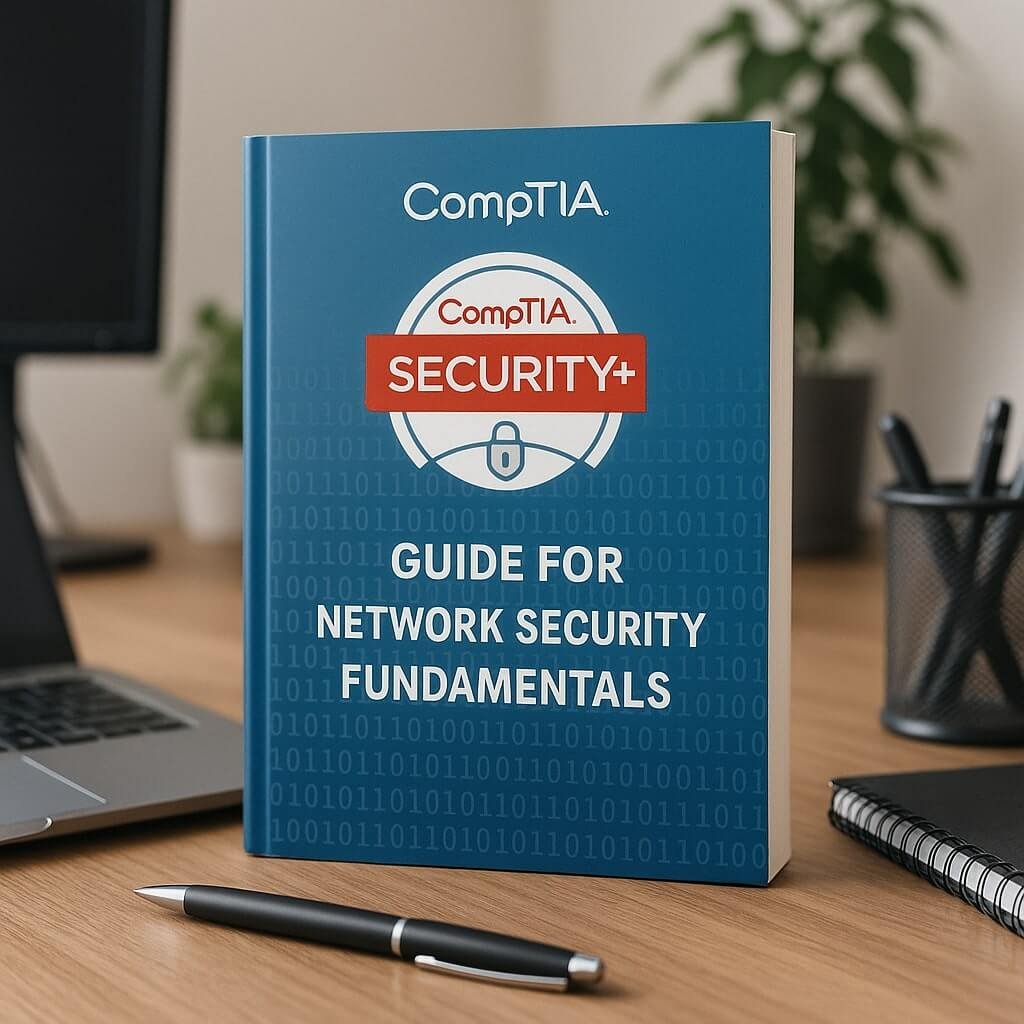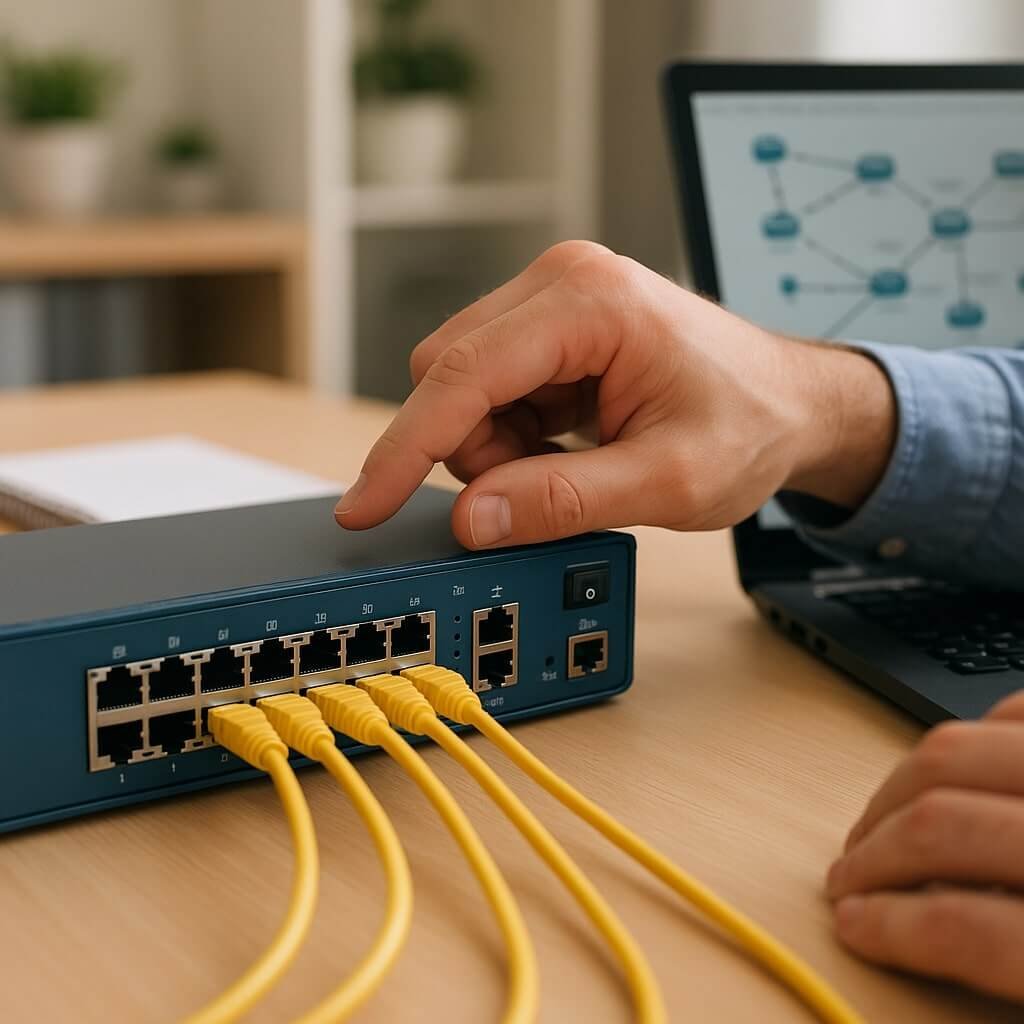The CompTIA Security Guide for Network Security Fundamentals serves as a critical resource for understanding network security principles. It focuses on key areas such as risk management, access controls, and encryption, all essential for protecting your digital assets. By emphasizing practical applications and real-world implementations, the guide prepares you to address evolving cyber threats. But how effectively can you apply these strategies to enhance your organization’s security posture?
Key Takeaways
- The CompTIA Security Guide is a comprehensive resource focused on network security fundamentals and best practices.
- It covers essential topics like risk management, access controls, encryption, and incident response strategies.
- The guide emphasizes practical applications of security protocols to establish a strong security posture.
- It aids in understanding security architecture, including frameworks like Defense in Depth and Zero Trust.
- Regular updates and user training are highlighted as critical components for minimizing vulnerabilities and enhancing cyber hygiene.
Overview of the CompTIA Security Guide
The CompTIA Security Guide serves as a thorough resource for understanding network security fundamentals. You’ll find it essential for grasping the intricacies of security protocols that safeguard your network environment.
This guide systematically breaks down various aspects of network security, including risk management, access controls, and encryption techniques. By analyzing these components, you can effectively establish a robust security posture.
Each section focuses on practical applications of security protocols, ensuring you understand not just the theory but also how to implement these strategies in real-world scenarios.
Key Principles of Network Security
Understanding the key principles of network security is essential for anyone tasked with protecting an organization’s digital assets.
Understanding network security principles is crucial for safeguarding an organization’s digital assets effectively.
To effectively safeguard your network, focus on these core principles:
- Access Controls: Implement strict access controls to guarantee only authorized personnel can access sensitive data.
- Authentication Methods: Use robust authentication methods, like multi-factor authentication, to verify users’ identities before granting access.
- Data Encryption: Encrypt data in transit and at rest to protect it from unauthorized interception and breaches.
- Regular Updates: Keep software and systems updated to mitigate vulnerabilities and prevent attacks.
Risk Management in Network Security
While managing risk in network security, you need to identify, assess, and prioritize potential threats to your organization’s information assets. Start with a thorough risk assessment to understand vulnerabilities and their impact on your operations.
This process not only reveals weaknesses but also helps you align your security measures with compliance requirements mandated by industry regulations. By evaluating risks systematically, you can implement effective controls and allocate resources where they’re most needed.
It’s essential to regularly review and update your risk management strategy, adapting to emerging threats and changes in compliance standards. Ultimately, a proactive approach to risk management enhances your organization’s resilience against cyber threats while ensuring you meet all necessary legal obligations.
Understanding Security Architecture
As you explore security architecture, it’s vital to recognize that a well-structured framework serves as the backbone of an organization’s cybersecurity posture.
Security frameworks and architectural models provide guidance for establishing robust defenses. Consider the following components:
- Defense in Depth: Multiple layers of security to deter threats.
- Zero Trust: Continuous verification of user identities and devices.
- Network Segmentation: Dividing networks to limit potential breaches.
- Security Policies: Clearly defined protocols for incident response and data protection.
Integrating these elements guarantees a thorough approach to security architecture.
Threat Mitigation Strategies
Effective threat mitigation strategies are essential for minimizing risks and safeguarding your organization’s assets.
Start with robust threat detection systems that continuously monitor for anomalies and suspicious activities within your network. Utilize automated tools for real-time alerts, allowing you to respond swiftly to potential threats.
Conduct regular vulnerability assessments to identify and address weaknesses in your infrastructure before they can be exploited. Prioritize these vulnerabilities based on their potential impact and exploitability, ensuring that your resources are allocated effectively.
Implement layered security measures such as firewalls, intrusion detection systems, and endpoint protection to create a thorough defense.
Best Practices for Cybersecurity
To establish a robust cybersecurity posture, organizations must adopt a series of best practices that address both technical controls and user behavior.
Prioritizing cyber hygiene is essential to minimize vulnerabilities and guarantee a secure environment.
Prioritizing cyber hygiene is crucial for minimizing vulnerabilities and ensuring a secure organizational environment.
Here are four key practices to implement:
- Regular Software Updates: Keep all systems and applications patched to defend against known exploits.
- Strong Password Policies: Enforce complex password requirements and encourage regular changes to enhance security.
- Incident Response Planning: Develop and test a thorough response plan to effectively manage security incidents.
- User Training: Conduct ongoing training sessions to educate employees about potential threats and safe online practices.
Benefits of Utilizing the CompTIA Security Guide
Utilizing the CompTIA Security Guide greatly enhances your security knowledge, equipping you with the necessary frameworks to identify and mitigate threats.
You’ll also develop practical skills that can be directly applied to real-world scenarios, improving your effectiveness in network security.
This combination of theoretical understanding and hands-on experience positions you to respond adeptly to evolving security challenges.
Enhanced Security Knowledge
While traversing the complexities of network security, you’ll find that the CompTIA Security Guide substantially enhances your understanding of critical security concepts.
This guide empowers you by providing insights into:
- Enhanced threat detection techniques that proactively identify vulnerabilities.
- Advanced security protocols that bolster data integrity and confidentiality.
- Regulatory compliance measures to align with industry standards.
- Risk management frameworks to effectively assess and mitigate threats.
Practical Skills Development
As you explore the CompTIA Security Guide, you’ll discover that it not only enhances your theoretical knowledge but also cultivates practical skills essential for real-world application. The guide emphasizes hands-on training, allowing you to engage directly with security tools and techniques. This approach guarantees that you’re not just learning concepts but actively applying them, which is vital in the tech landscape. Skill assessments embedded within the guide enable you to evaluate your progress and identify areas for improvement, fostering continuous development.
| Training Aspect | Description | Benefit |
|---|---|---|
| Hands-on Training | Engaging with real security tools | Practical experience |
| Skill Assessments | Evaluating knowledge and skills | Targeted improvement |
| Application Scenarios | Real-world problem-solving | Enhanced readiness |
Conclusion
To summarize, the CompTIA Security Guide for Network Security Fundamentals is an invaluable resource for enhancing your understanding of network security. By focusing on key principles, risk management, and threat mitigation strategies, you’re equipped to implement effective cybersecurity measures. Utilizing this guide not only sharpens your skills but also strengthens your organization’s security posture against evolving threats. Embracing the best practices outlined will ultimately lead to a more resilient and secure network environment.






